Simmons C.H., Dennis E.M. Manual of Engineering Drawing
Подождите немного. Документ загружается.

280 Manual of Engineering Drawing
Slovakia (SUTN)
Slovak Institute for Standardization
P.O. Box 246
Karleveska 63
84000 BRATISLAVA 4
E-Mail mspost@sutn.gov.sk
Web www.sutn.gov.sk.
Slovenia (SMIS)
Standards and Metrology Institute of
the Republic of Slovenia
Kotnikova 6
SI-1000 LJUBLJANA
E-Mail smis@usm.mzt.si
Web www.usm.mzt.si/
South Africa (SABS)
South African Bureau of Standards
1 Dr Lategan Rd, Groenkloof
Private Bag X191
PRETORIA 0001
E-Mail info@sabs.co.za
Web www. sabs.co.za/
Spain (AENOR)
Asociacion Espanola de
Normalizacion y Certificacido
Genova, 6
E-28004 MADRID
E-Mail aenor@aenor.es
Web www.aenor.es/
Sri Lanka (SISI)
Sri Lanka Standards Institution
17 Victoria Place
Off Elvitigala Mawatha
P.O. Box 17
COLOMBO 08
E-Mail dgslsi@sltnet.Ik
Web www.nsf.ac.lk/sisi/
Sweden (SIS)
SIS, Swedish Standards Institute
S:t Eriksgatan 115
S-11343 STOCKHOLM
Postal address
Box 6455
S-11382 STOCKHOLM
E-Mail info@sis.se
Web www.sis.se/
Switzerland (SNV)
Swiss Association for Standardization
Burglistrasse 29
8400 WINTERTHUR
E-Mail info@snv.ch
Web www.snv.ch/
Syrian Arab Republic (SASMO)
Syrian Arab Organization for
Standardization and Metrology
P.O. Box 11836
DAMASCUS
E-Mail sasmo@net.sy
Tanzania. United Republic of (TBS)
Tanzania Bureau of Standards
Ubuno Area
Morogoro Road/Sam Nujema Road
DAR ES SALAAM
Postal address
P.O. Box 9524
DAR ES SALAAM
E-Mail tbs@simbanet.net
Thailand (TISI)
Thai Industrial Standards Institute
Ministry of Industry
Rama VI Street
BANGKOK 10400
E-Mail thaistan@tisi.go.th
Web www.tisi.go.th/
The former Vugoslav Republic of Macedonia (ZSM)
Zaved za standardizacija metrologija
Ministry of Economy
Samoilova 101000 SKOPJE
E-Mail zsm@zsm.gov.mk
Trinidad and Tobago (TTBS)
Trinidad and Tobago Bureau of Standards
Lot 1 Century Drive
Trincity Industrial Estate
TUNAPUNA
Postal address
P.O. Box 467
PORT OF SPAIN
E-Mail ttbs@carib-link.net
Web www opus.co.tt/ttbs/
Tunisia (INNORPI)
Institut national de la normalisatien et
de la propriete industrielle
B.P. 23
1012 TUNIS-BELVEDERE
E-Mail inorpi@email.ati.tn
Turkey (TSE)
Turk Standardlari Enstitusu
Necatibey Cad. 112
Bakanliklar
TR-06100 ANKARA
E-Mail usm@tse.org.tr
Web www.tse.org.tr
Ukraine (DSTU)
State Committee of Standardization,
Metrology and Certification of Ukraine
(Derjstandart of Ukraine)
174 Gorkiy Street, 03680, KYIV-680
E-Mail dst1@dstul.kiev.ua
United Arab Emirates (SSUAE)
Directorate of Standardization and Metrology
Ministry of Finance and Industry
El Falah Street
P.O. Box 433, ABU DHABI
E-Mail standard. mofi@uae.gov.ae
Web www.uae.gov.ae
Related standards 281
United Kingdom (BSI)
British Standards Institution
389 Chiswick High Road
GB-LONDON W4 4AL
E-Mail standards.international@bsi-global.com
Web www.bsi-global.com
Uruguay (UNIT)
Institute Uruguayo de Normas
Tecnicas
Pza. Independencia 812, Piso 2
MONTEVIDEO
E-Mail unit-iso@unit.org.uy
Web www.unit.org.u
USA (ANSI)
American National Standards Institute
1819 L Street, NW
WASHINGTON, DC 20036
Postal address
11 West 42nd Street, 13th floor
New York, N.Y 10036
E-Mail info@ansi.org
Web www.ansi.org/
Uzbekistan (UZGOST)
Uzbek State Centre for Standardization,
Metrology and Certification
Ulitsa Farobi, 333-A
700049 TACHKENT
Venezuela (FONDONORMA)
Fondo pare a Normalizacion y
Certificacion de Ia Calidad
Avenida Andres Bello, Edf. Torre Fondo Comun
Pisos 11 y 12, Apartado Postal 51116
CARACAS 1050-A
E-Mail central@fondonorma.org.ve
Web www.fondonorma.org.vE
Viet Nam (TCVN)
Directorate for Standards and Quality
70, Tran Hung Dao Street
HANOI
E-Mail khht@fpt.vn
Web tcvn.gov.vn
Yugoslavia (SZS)
Savezni zavod za Standardizaciju
Kneza Milosa 20
Post fah 609
YU-11000 BEOGRAD
E-Mail jus@szs.sv.gov.yu
Zimbabwe (SAZ)
Standards Association of Zimbabwe
(SAZ)
P.O. Box 2259
HARARE
E-Mail sazinfo@mweb.co.zw

The following three typical drawings are included as
examples of draughtsmanship, layout, dimensioning,
and tolerancing.
Figures 31.1 and 31.2 show a pulley and a shaft,
and illustrate some aspects of general dimensioning
and tolerancing.
Figure 31.3 shows a partly dimensioned elevation and
plan view of a proposed gear-box cover, with a wide
application of theoretically exact boxed dimensioning
and the associated positional tolerances. To emphasize
this style of dimensioning, other dimensions relating to
the form of the cover have been omitted.
Completed drawings are usually presented on
company standard sheets. Sizes, areas and designations
are given at the start of Chapter 5. The layout of a
typical sheet contains information required for
identification, administration and interpretation and a
company could design several types of standard sheets,
particularly appropriate to their products.
If drawings are produced manually, then the drawing
sheets may be supplied with printed borders and blocks
containing relevant notes and headings. With CAD
layouts, similar details are stored in the database.
Figures 31.4 to 31.7, clearly show that documentation
can occupy much of the sheet area. The space provided
for basic and supplementary information will be decided
by the company; its actual position on the sheet may
vary with the sheet size.
Chapter 31
Production drawings
Part No.
9900
12 34
15
0,5 Y
A
A
B
ø34
A
84
6 Holes
Equispaced
ø0.1
X
Drill ø 3,25 × 16 deep
Tap M4 × 0,7 × 12 deep
C’SK ø4,5 × 90°
Machine all over
Unspecified tolerances ± 0.2
Unspecified radii 3 mm
ProjectionIssue no
Date
First used on
Equivalent part
Dimensions in millimetres (mm)
Original scale 1:1
Drawn by R7
Approved by CNS
Material SPEC
220M07
Treatment
Title
Hub pulley
Name of firm
12 1214
B
2 × 45°
Y
0,4
ø 80
24,6
ø 24,5
0,4
20,55
ø 20,50
R2
1
ø 40
R2
ø15,8
20,55
ø20,50
50,73
ø50,65
Both
sides
10
20
2 × 45°
2 × 45°
2×45°
X
64
0,01
Y
ø 0,05
M
2 Holes
Drill ø 4,92 × 15 deep
Tap M6 × 1 × 11 deep
C’BORE ø 8 × 4,5 deep
Scrap view in direction
of arrow B
10
7,5
4 × 45°
42
Section A–A
Similar to 9880
Scheme Ref S 525
Part No.
9900
A2
0.5
Y
Fig. 31.1
∅ 90
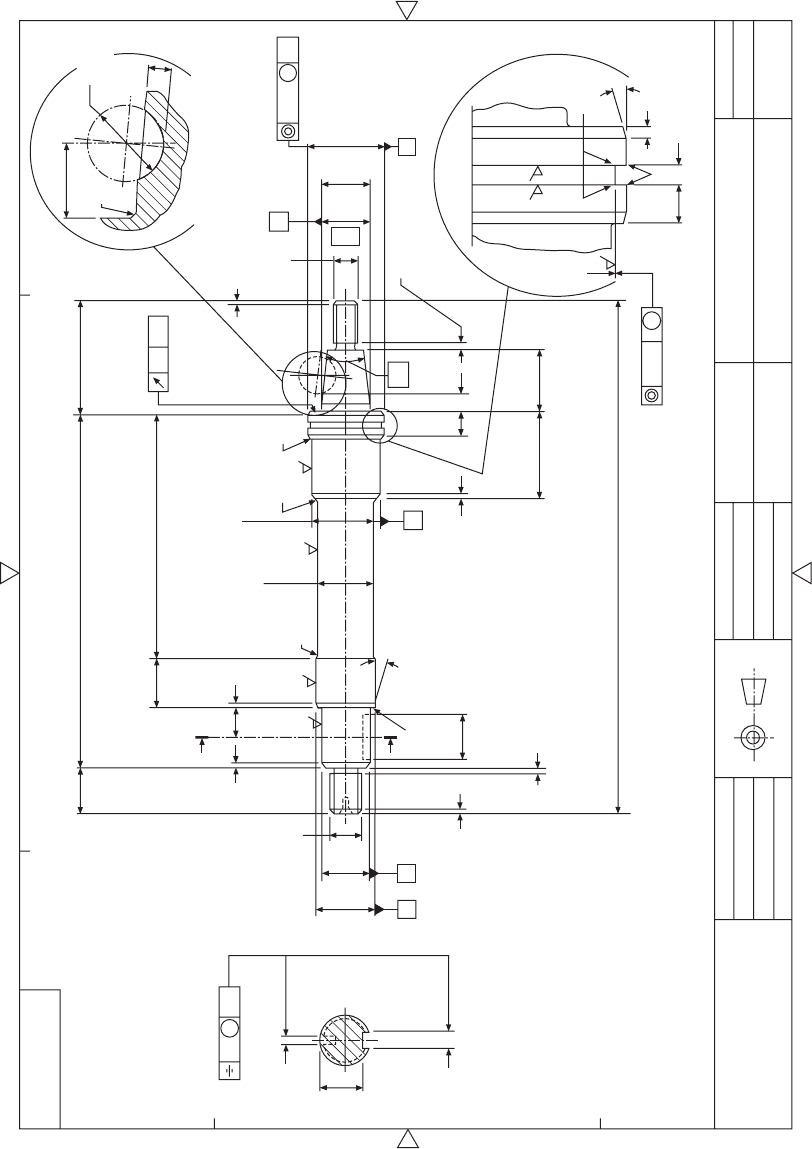
Part No.
1234
A
B
C
D
0.1
M
D–E
3,988
3,937
8,000
7,964
21
Scrap section X
–X
Machine all over
Unspecified tolerances
± 0,2
Copyright note
Issue No.
Date
First used on
Equivalent part
Third angle projection
Dimensions in milimetres (mm)
Original scale 1:1
Drawn by A,7
Approved by D.M
Material SPEC
826M31
Treatment
Title
SHAFT
Name of firm
Similar to 7678
Scheme Ref S,750
Part No.
1234
A2
ø0,05
M
Detail of groove. scale 4:1
5
R 0,5
2,64
2,44
1,5
Both sides
15°
0,76
R 0,51
0,8
0,8
0,8
36,15
ø 36,10
Undercut
x 3,2 wide
R 0.8 in corners
10,2
ø 10,0
C
39,20
ø39,15
ø24
ø23
D
M12 × 1,25
1 × 45°
ø 0,02
M
A–B
Details of
keyway.
Woodruff
scale 2:1
5,8
19,00
ø18,75
19
R 0,1
0,1 A–B
5617824
29,960
ø29,927
M16 × 1,5
AE
1,5 × 45°
X
R 0,1
23,25
23,00
13,8
Undercut ø 13,6
× 3,2 wide
R 0,8 in corners
2 × 45°
X
15 1,5
0,4
0,2
R0,3
15°
28,0
ø 27,9
0,4
34,950
ø 34,911
R0,3
0,2
R0,1
B
18°
12,5
9,2
9,0
42,5 32
(258)
25,000
ø24,95
25 123
1,5 × 45°
c
123
4
Fig. 31.2
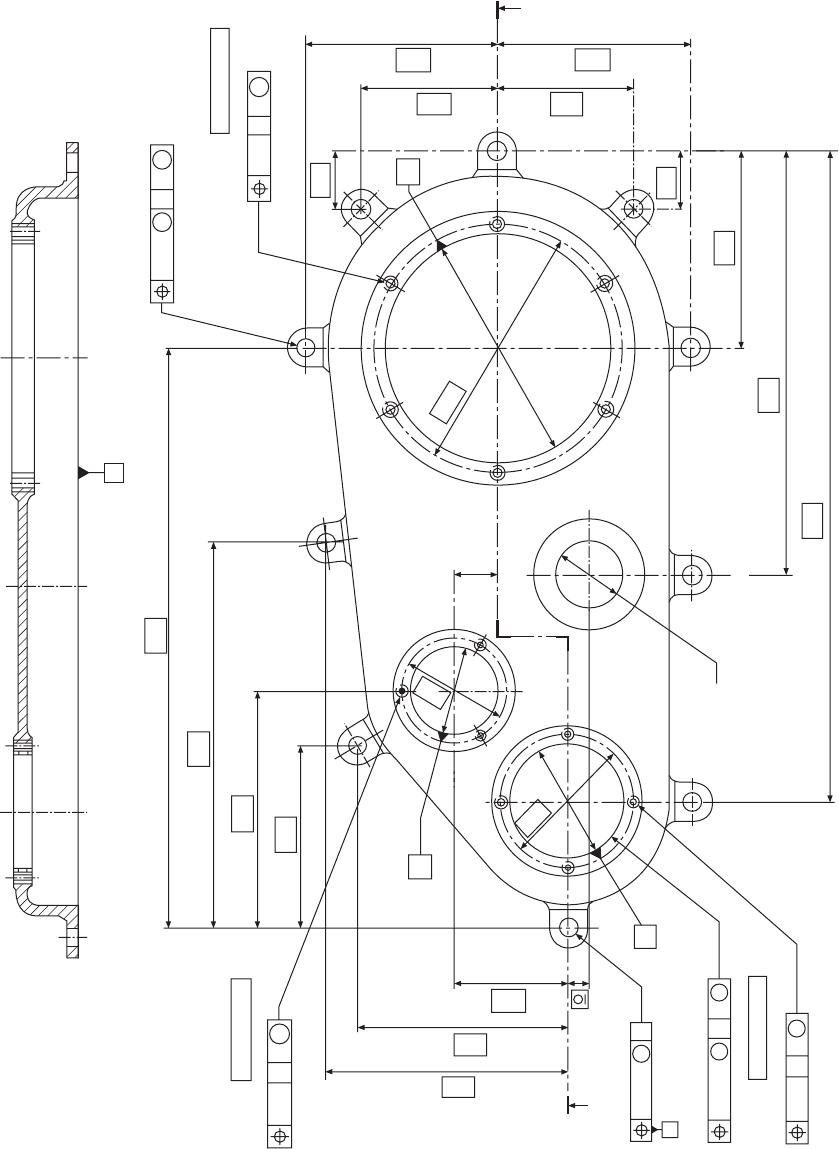
3 Holes
Equispaced
M4 × 0.7 – 6H
ø0,2
E
M
107
93
50
Y
50,03
ø 50,00
B
8.022
2 Holes ø 8.000 Y & Z
X
ø 0.03 M E
M
M
Holes F.B.C and D
A
0 0,05 E A
4 Holes
Equispaced
M4 × 0.7 – 6H
ø 0,2
E
B
M
Hole F
30,025
ø 30,000
285
185
85
25
60
58
60
58
D
Z
25
100,035
ø 100,000
ø110
19,5
ø48
ø 58
40,025
ø 40,000
C
80
105
170
255
Section X–X
E
8,3
8 Holes ø 8,0
ø 0,2
M
EA
M
6 Holes
M6 × 1 – 6H
ø 0,2
E
D
M
Equispaced
Proposed gear box cover
material L M,4
X
Fig. 31.3
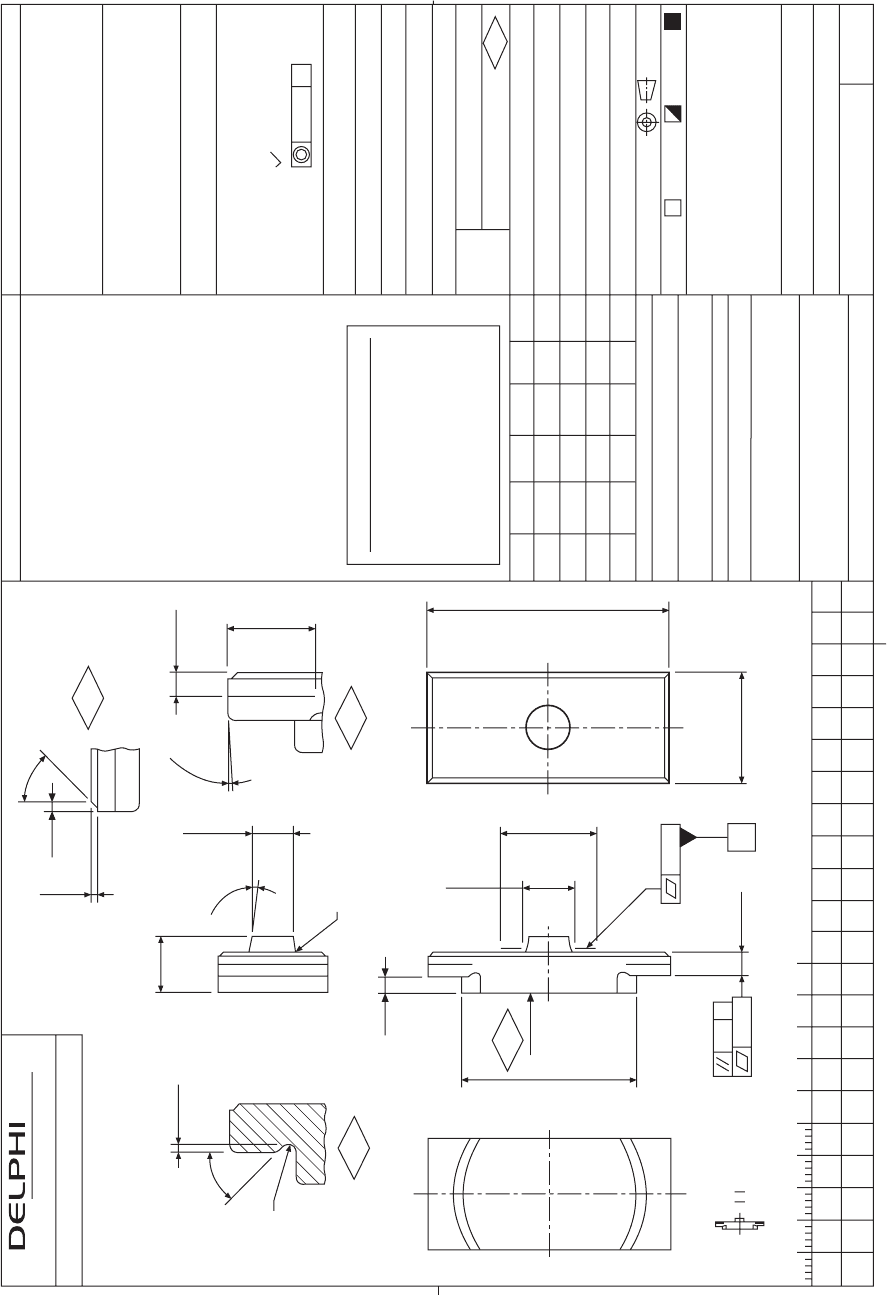
Automotive systems
No. 7204/0131
0,25
R 0,25
45°
10:1
n4
1,0
0,8
11,2
11,0
ø
n5
0,1
0,05
A
A
0,05
1,57
1,43
6,9
6,7
15,2
15,0
ø6
ø3,3
n3
(2,8)
2° max
2,7
2,5
ø
8°
6°
3,5
0,3
0,1
0,4
0,2
45°
n6
10:1
0.75
R 0,25 max
:
10 20 30 40 50 60 70 80 90 100
Notes Copyright
n1 Density to be checked in accordance
with BS 5600 : Part 3 :
Section 3.2 : 1988.
ISO 2738 : 1987
n2 Unspecified radius 0,2 allowable on
all edges. (Not shown on 5:1 views)
n3 Detail of draft feature along all flange
edges.
n4 Detail of U/CUT.
n5 Hardness to be checked in
accordance with
BS EN 24498–1: 1993
ISO 4498–1 : 1990.
In area indicated.
n6 Detail of edge chamfer.
EMISSIONS CERTIFIED PRODUCT
This product has been certification
tested. NO CHANGE to approved
process, material, specification
or supplier is permitted without
formal DELPHI DIESEL SYSTEMS
ENGINEERING APPROVAL
This drawing/or document is copyright and the property of
Delphi Diesel Systems. It must not be copied (in whole or in
part), used for manufacture or otherwise disclosed without
prior written consent of the company. Any copies of this
drawing made by any method must also include a copy of
this legend. © Delphi Diesel Systems 1991
Unless otherwise stated the following are in accordance
with the standard no(s) quoted:
1. Symbols & abbreviations to ISO 1101
2. I.S.O. metric threads to ISO 262 & 965
3. I.S.O. unified threads to ISO 263 & 5864
Dimensions in millimetres (mm)
Remove sharp edges
Unless otherwise stated tolerances
Linear ± 0,2 3,2 Angular ± 3°
Surface roughness
All diameters to be
unless otherwise stated
ø 0,1
–
Supersedes
3P × 763/151
Similar to
REF DRG No
First used on
–
–
7204/0100
Material
Steel
Specification
Form
4–6–538A
Sinter
n1
Heat treatment
Finish
R. Trickett
Checked
–
Natural
Drawn
–
Checked
–
Translated by
–
Approved
CTT
Date
13/4/91
Projection
Current Service Cancelled
Delphi Diesel Systems
Concord Road
London W3 OSE
Classification code No.
No. 7204/0131
Sheet
1/1
4
JCB
1/9/94
3
2
1
JCB
7/6/93
JCB
26/2/92
13/4/91
5
6
7
JCB
18/4/97
JCB
9/2/96
JCB
30/10/95
Issue
No.
Date &
source
Issue
No.
Date &
source
Issue
No.
Date &
source
Changes
This drawing may only be altered or replaced in
accordance with procedure
Do not measure undimensioned features
Title
Yo ke – Spring
Original scale
5 : 1
10:1
A3 English –
Fig. 31.4
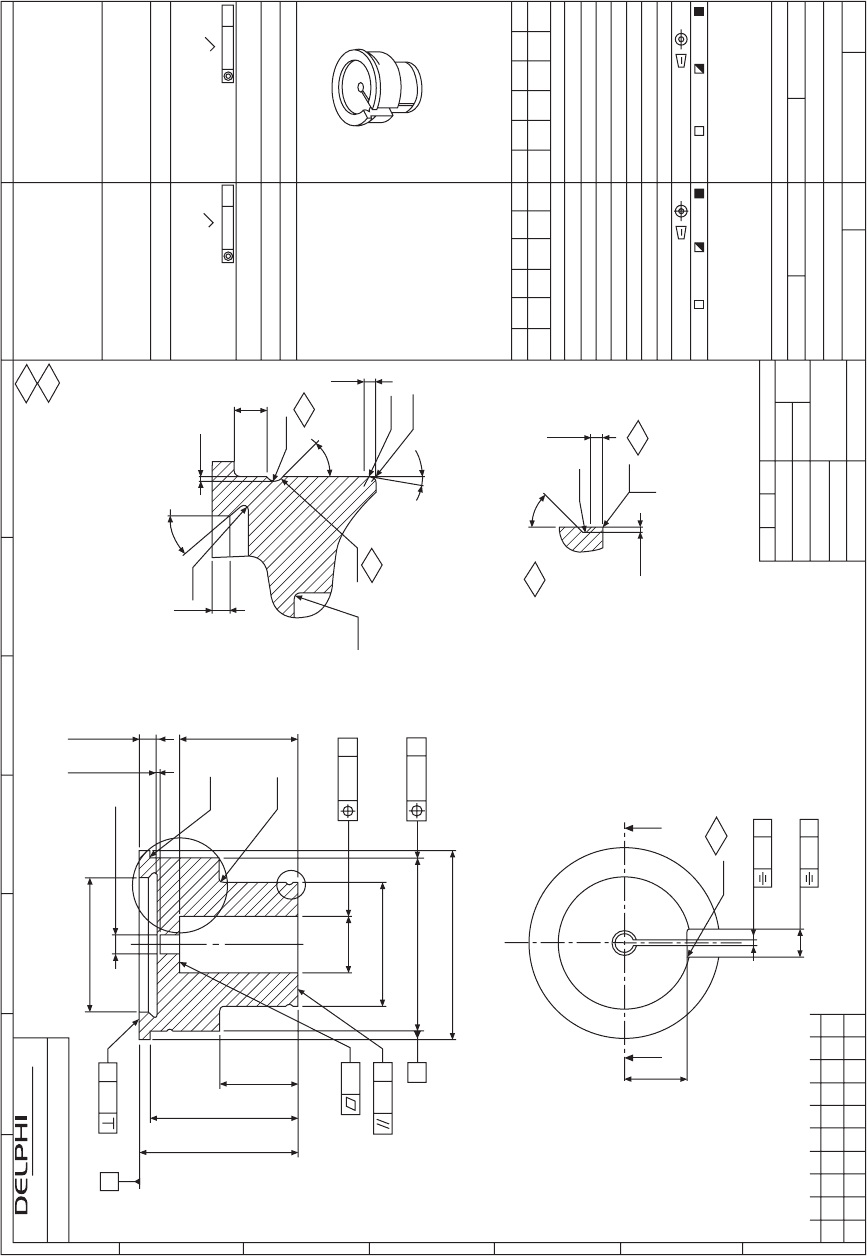
No. 7206-0086
Automotive systems
FIRST ANGLE PROJECTION
B
0,02
A
ø11,9
ø1,7±0,02
0,2 × 45°
1,610,5
R 0,2
R 0,2
0,02
A
0,02
A
Y
X
14,1 ± 0,03
13,1 ± 0,03
6.9 ± 0,02
0,01
0,02
B
A
ø5±0,02
ø11 ± 0,02
ø15,38 ± 0,01
ø16,7
Z–Z
5,55
ZZ
R 0,2
n1
0,5 ± 0,02
2,5
0.05 A
0.05 A
10 20 30 40 50 100
〈M〉
〈M〉
〈M〉
B
4-2-550
Bar
19-25-86
-
Natural
..
Country
Specification
Form
Heat treatment
Hardness
Finish
Meterial
Silicon
Iron
n1
n4
45°
0,2
R 0,2
–0,05
0,5
Y(10 : 1)
10°
R 0,2
R 0,5
0,5
1,5
45°
n1
n1
R 0,2R 0,2
R 0,2
0,2
40°
R 0,2
0,8
n2
n3
A
B
C
D
E
F
G
12 34 56 7
Copyright Droit de reproduction
Notes Remarques
n1 2 Places.
n2 For all Radii, equivalent
edge condition to ISO
13715 acceptable.
n3 Unless otherwise
stated surface finish is
Ra.
n4 Edge condition to ISO
13715.
Isometric view
(2:1)
This drawing/or document is copyright and the
property of Delphi Diesel Systems it must not
be copied (in whole or in part), used for
manufacture or otherwise disclosed without prior
written consent of the company. Any copies of
this drawing made by any method must also
include a copy of this legend.
© Delphi Diesel Systems 2001
Ce dessin ou document est prolege par un droit
de reproduction et est la propriete de Delphi
Diesel Systems il ne doit pas etre copie (en entier
ou en parlie.), utilise pour la fabrication ou
divulgue sans accord ecrit de la societe. Toutes
les copies de ce dessin realisees par un
quelconque procede doivent egalement
comporter un copie du cartouche.
© Delphi Diesel Systems
Unless otherwise stated the following are in
accordance with the standard nos quoted:
1. Metric threads to ISO 262 & 965.
2. Unified threads to ISO 263 & 5864.
3. Symbols & Abbreviations to ISO 1101.
All standards are to latest issue unless
otherwise stated.
Sauf mention particuliere ce dessin est conforme
aux standards suivants:
1. Filetages metriques ISO 262 ET 965
2. Filetages unifies 263 ET 5864
3. Symbols ET Abbreviations ISO 1101
Dimensions in millimetres (mm)
Remove sharp edges
Unless otherwise stated:
–Tolerances
Linear ± 0.05
Angular ± 1°
All diameters to be
1.6
Surface roughness
ø 0.05
A
ø .
.
Dimensions en millimetres (mm)
Ebavurer partout
Sauf indications particulieres:
–tolerances generales
Lineaires ±
Angulaires ±
Tout diametre doit etre
.
Etat de surface
This drawing may only be altered or replaced in
accordance with procedure
Ce dessin ne doit seulement etre modifie ou remplace
que conformement aux procedures defines
Do not measure undimensioned features
Ne pas mesurer les dimensions non indiquees
.
:
.
:
.
:
.
:
E1
Issue
No.
Date &
source
Issue
No.
Date &
source
Issue
No.
Date &
source
Date &
origine
Date &
origine
Date &
origine
Edition Edition Edition
CHANGES MODIFICATIONS
Supersedes _
Similar to _
Ref. Drg. No. 45-00004982/45-00004985
First used on PF1039
Drawn Mem Checked _
Translated by _ Checked _
Approved ARK Date 21/11/2001
Projection
..
..
Remplace dessin No. _
Dessin similare A No. _
Dessin de reference _
1er Emploi pour _
Dessine _ Verifie _
Traduit _ Verifie _
Approuve _ Date _
Projection
En cours Rechange Annule
Current Survice Cancelled
Delphi Diesel Systems
Concord Road
London W3 OSE
Delphi Diesel Systems
Concord Road
London W3 OSE
3
〈M〉
:0
〈L〉
:0
〈C〉
:
Original scale
5:1
Code _
Title
Core-Stator
Classification code _
No. 7206-0086
Sheet
1/1
No. 7206-0086
Feuille
·/·
A2
···
Echelle D’origine Diffusion
·
Designation
·
Classification du numero de code
·
·
E2
21/11/01
Mem
08/04/02
Mem
X(10:1)
Fig. 31.5
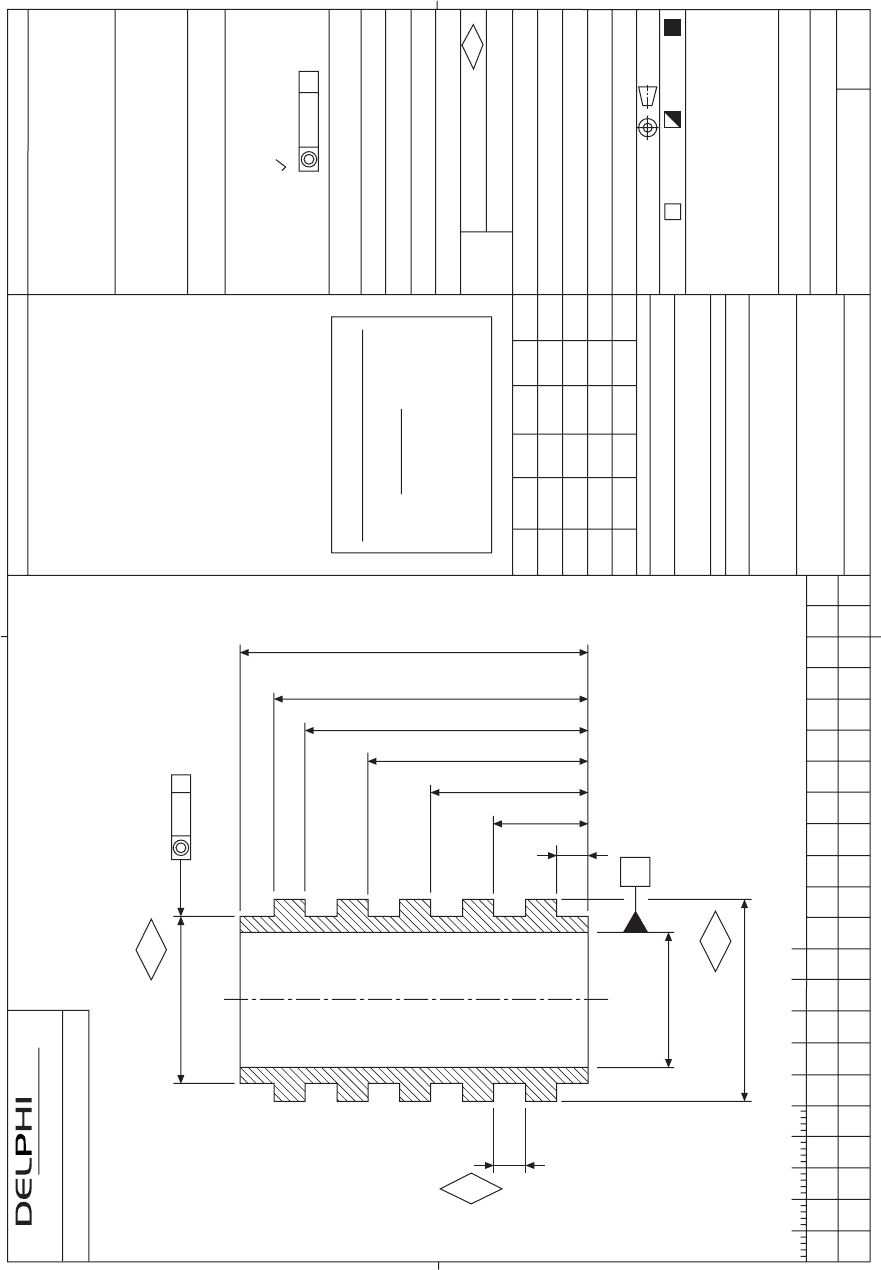
Automotive systems
No. 7204/0031
5,5
5,3
ø
n3
ø 0.1
A
n1
4,35
4,25
ø
n2
(ø6,5)
A
10 20 30 40 50 60 70 80 90 100
3
5
7
9
10
11,15
11,05
1
1
Notes
Copyright
n1 4 places.
n2 Diamond knurl
45 TPI. 0.022′′ Pitch.
5 Places.
n3 6 places.
n4 Alternative specification
4–1–262A.
This drawing/or document is copyright and the property of
Delphi Diesel Systems. It must not be copied (in whole or in
part), used for manufacture or otherwise disclosed without
prior written consent of the company. Any copies of this drawing
made by any method must also include a copy of this legend.
© Delphi Diesel Systems 1988
Unless otherwise stated the following are in accordance with
the standard no(s) quoted:
1. Symbols & abbreviations to ISO 1101
2. I.S.O. metric threads to ISO 262 & 965
3. I.S.O. unified threads to ISO 263 & 5864
Dimensions in millimetres (mm)
Remove sharp edges
Unless otherwise stated tolerances
Linear ± 0,2 1,6 Angular ± –
Surface roughness
All diameters to be
unless otherwise stated
ø– –
Supersedes –
Similar to –
Ref DRG No 3P × 757/35
First used on 7204/0044
n4
Material
STEEL
Specification
4–1–597
Form
Natural
Bar
Heat treatment
Finish
–
Drawn Checked
NRM –
Translated by
–
Checked
–
Approved Date
CTT 27/2/88
Projection
Current Service Cancelled
Delphi Diesel Systems
Concord Road
London W3 OSE
Classification code No.
No. 7204/0031
Sheet
1/1
EMISSIONS CERTIFIED PRODUCT
This product has been certification
tested. NO CHANGE to approved
process, material, specification or
supplier is permitted without formal
Delphi Diesel Systems
ENGINEERING APPROVAL
1
2
3
4
JCB
2/7/93
JCB
21/10/91
JCB
13/7/89
JCB
27/2/88
Issue
No.
Date &
source
Date &
source
Date &
source
Issue
No.
Issue
No.
Changes
This drawing may only be altered or replaced in accordance
with procedure
Do not measure undimensioned features
Title
Tube – Spacer
Original scale
10 : 1
A3 English–
0.25′′
Fig. 31.6
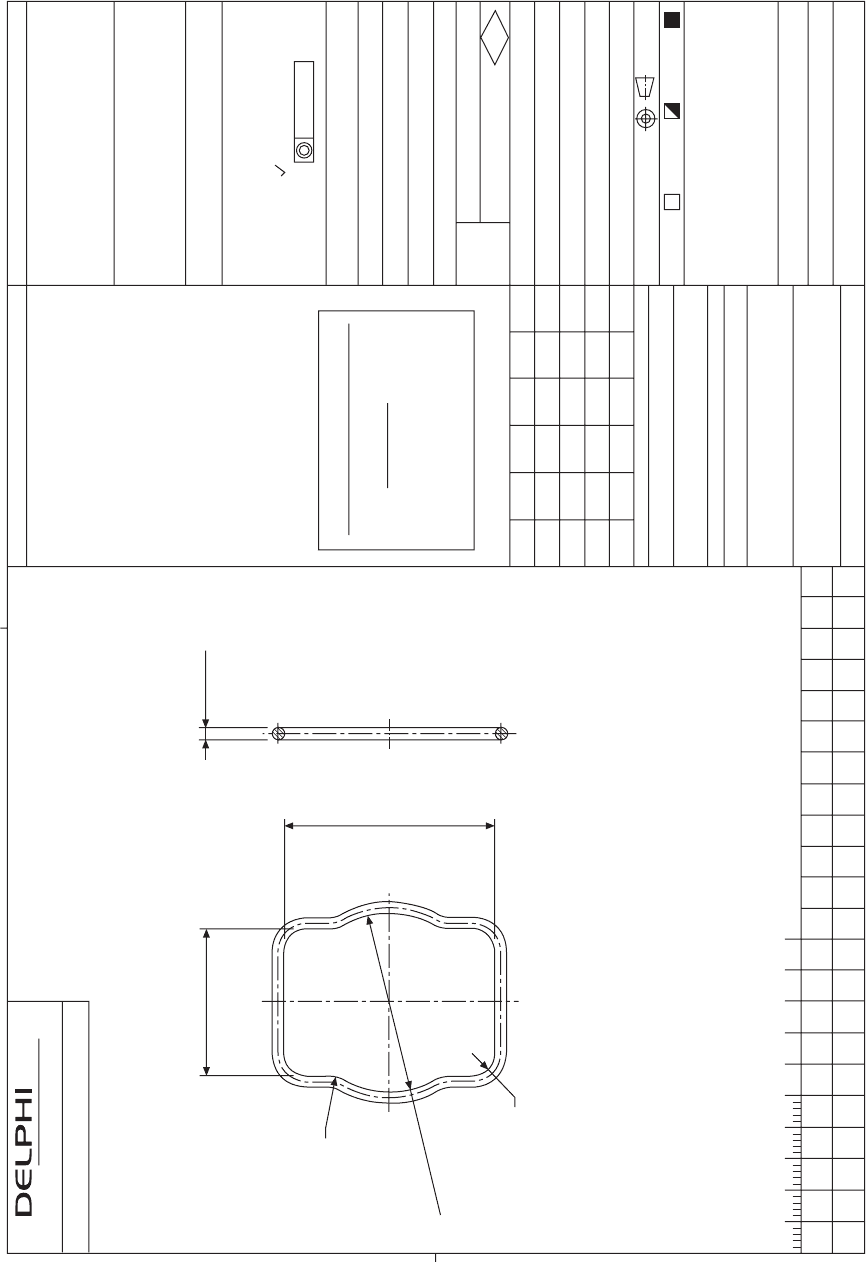
Automotive systems
No. 7204/0140
(23,6)
(R 4,7)
(ø28,7)
(R 3,7)
(33,7)
1,86
1,70
ø
10 20 30 40 50 60 70 80 90 100
Notes Copyright
n1 Combined flash
must conform to
BS 6442 : 1984
Grade N.
EMISSIONS CERTIFIED PRODUCT
This product has been certification
tested. NO CHANGE to approved
process, material, specification or
supplier is permitted without formal
Delphi Diesel System
ENGINEERING APPROVAL
1
2
3
4
JCB
17/9/93
JCB
7/5/92
JCB
21/2/92
7/10/91
Issue
No.
Date &
source
Date &
source
Date &
source
Issue
No.
Issue
No.
Changes
This drawing may only be altered or replaced in accordance
with procedure
Do not measure undimensioned features
Title
Seal – Actuator body
Original scale
2 : 1
–
Heat treatment
Finish
–
Drawn Checked
R. Trickett –
Translated by
– Checked
–
Approved Date
CTT 27/9/91
Projection
Current Service Cancelled
Delphi Diesel Systems
Concord Road
London W3 OSE
Classification code No.
No. 7204/0140
Sheet
1/1
A3 English–
5
JCB
3/2/94
n1
Supersedes
–
Similar to
–
Ref DRG No
First used on
Material
RUBBER
Specification
Form
Moulding
6–18–197
7204/0149
3P × 763/155
This drawing/or document is copyright and the property of
Delphi Diesel Systems. It must not be copied (in whole or in
part), used for manufacture or otherwise disclosed without
prior written consent of the company. Any copies of this drawing
made by any method must also include a copy of this legend.
© Delphi Diesel Systems 1991
Unless otherwise stated the following are in accordance with
the standard no(s) quoted:
1. Symbols & abbreviations to ISO 1101
2. I.S.O. metric threads to ISO 262 & 965
3. I.S.O. unified threads to ISO 263 & 5864
Dimensions in millimetres (mm)
Remove sharp edges
Unless otherwise stated tolerances
Linear ± –– Angular ± –
Surface roughness
All diameters to be
unless otherwise stated
ø ––
Fig. 31.7
Production drawings 289
Engineering progress over the years has resulted in
the issue of many Standards and clearly there are literally
millions of drawings in circulation, which may contain
minor details that have been superseded. It has been
the custom in a drawing title block to record a brief
note of dates when changes and modifications have
occurred. A typical drawing number could be known
as, for example: HB 345, for the original issue. Then
HB 345A for the first reissue, HB 345B, for the second
reissue. A brief note may be added to the drawing
relating to the change. Each manufacturer will have
their own system for recording full details and also
advising current users that a change has occurred.
Examples are shown on some of the following
illustrations.
In the case of textbooks, the front page generally
states the publishing dates and obviously general
standards used are appropriate to that date. Illustrations
of typical layouts are reproduced by kind permission
of Delphi Diesel Systems.
An advantage of producing a drawing on a CAD
system is that the draughtsman can complete the
illustration of the component or assembly on the screen.
He may reposition some parts if space permits, to avoid
congestion. The outline of the drawing sheet will be
taken from the database on a separate layer and placed
over the drawing to give a pleasing layout.
Draughtsmen have always derived much personal
satisfaction from producing drawings in ink or pencil
where the linework and lettering is uniform and neat,
and where the illustration completely defines the
requirements of the specification. A similar degree of
satisfaction can be obtained by producing drawings on
CAD equipment. Particular care with the spacings of
centre lines, contrasts in linework, cross hatchings,
positioning of dimensions, notes, etc, are all small
details in their own way, but they collectively contribute
to quality, balance and overall clarity. Check the reason
for the position of each and every line, ensure that it
conforms with the appropriate standard and that it
conveys a clear and unambiguous meaning to the reader.
Engineering drawings can be considered to be works
of art. We both hope you will produce many.
Further Standards for
design, project and risk
management of interest to
engineers and
manufacturers
Design management
The first priority of an organization is to ensure that it
survives and prospers. A business that fails to
continuously develop its product range is unlikely to
grow in real terms, especially with the increase in open
competition across the globe.
This major series of management standards helps
organizations plan ahead for products and services into
the future thus ensuring continuity of revenue streams.
The BS 7000 series – Design Management Systems
is divided into concise parts applicable to different
sectors.
BS 7000 – 1 Guide to managing innovation
BS 7000 – 2 Guide to managing the design of
manufactured products
BS 7000 – 3 Guide to managing service design
BS 7000 – 4 Guide to managing design in
construction
BS 7000 – 5 Guide to managing obsolescence
BS 7000 – 10 Glossary of terms used in design
management
The standards in this series are available individually
or in kit form. All six parts can also be ordered as
BS 7000 Design Management Systems kit 94.
Project management
BS 6079–1 Project Management describes a full range
of project management procedures, techniques and tools
that you can select as appropriate to your project. It
gives guidance on the planning and execution of projects
and the application of project management techniques.
The standard has a broad relevance to projects in many
industries including the public sector, both at home
and abroad. The principles and procedures outlined
are relevant to all sizes of organization.
This standard aims primarily to provide guidance
for relative newcomers to project management and to
act as an aide-memoir for more experienced practitioners
and those who interact with project management teams.
The other parts of BS 6079 are also available.
BS 6079–2:2000 Project Management–Vocabulary
BS 6079–3:2000 Project Management–Guide to the
Management of Business Related Project Risk
Project Management (kit 2)
Contains the three parts of BS 6079 at a reduced
price
BS 6079–4 Project management
Guide to project management in the construction
industry
BS IEC 62198
Project Risk Management Application Guidelines
This standard provides an internationally approved
process for managing project and project-related
risks in a systematic and consistent way. It is relevant
to decision-makers, including project managers, risk
managers and business managers.
BS IEC 62198 provides a general introduction to project
risk management, its sub-processes and influencing
factors, such as:
• Establishing the context, including confirmation of
project objectives
• Risk identification
